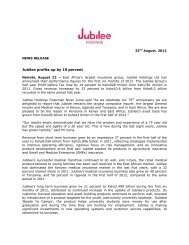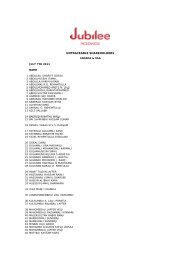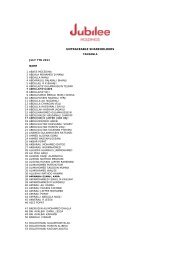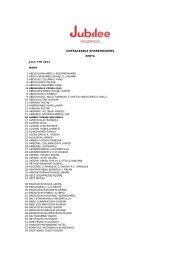Jubilee Insurance 2010 Annual Report
Jubilee Insurance 2010 Annual Report
Jubilee Insurance 2010 Annual Report
You also want an ePaper? Increase the reach of your titles
YUMPU automatically turns print PDFs into web optimized ePapers that Google loves.
JUBILEE HOLDINGS<br />
ANNUAL REPORT AND FINANCIAL STATEMENTS<br />
FOR THE YEAR ENDED 31 ST DECEMBER <strong>2010</strong><br />
29<br />
NOTES (continued)<br />
3. CRITICAL ACCOUNTING ESTIMATES AND JUDGEMENTS IN APPLYING<br />
ACCOUNTING POLICIES (Continued)<br />
The development of insurance liabilities provides a measure of the<br />
Group’s ability to estimate the ultimate value of claims.<br />
The determination of the liabilities under long-term insurance contracts is<br />
dependent on estimates made by the Group. Estimates are made as to<br />
the expected number of deaths for each of the years in which the Group<br />
is exposed to risk. The Group bases these estimates on standard mortality<br />
tables that reflect historical mortality experience. The estimated number<br />
of deaths determines the value of the benefit payments and the value of<br />
the valuation premiums. The main source of uncertainty is that epidemics<br />
such as AIDS could result in future mortality being significantly worse<br />
than in the past for the age groups in which the Group has significant<br />
exposure to mortality risk. However, continuing improvements in medical<br />
care and social conditions could result in improvements in longevity in<br />
excess of those allowed for in the estimates used to determine the liability<br />
for contracts where the Group is exposed to longevity risk.<br />
For contracts without fixed terms, it is assumed that the Group will be able<br />
to increase mortality risk charges in future years in line with emerging<br />
mortality experience.<br />
Under certain contracts, the Group has offered guaranteed annuity<br />
options. In determining the value of these options, estimates have been<br />
made as to the percentage of contract holders that will exercise them.<br />
There is not enough historical information available on which to base these<br />
estimates. Changes in investment conditions could result in significantly<br />
more contract holders exercising their options than has been assumed.<br />
Estimates are also made as to future investment income arising from the<br />
assets backing long-term insurance contracts. These estimates are based<br />
on current market returns as well as expectations about future economic<br />
and financial developments.<br />
a) Income tax<br />
The Group is subject to income taxes in various jurisdictions. There are<br />
many transactions and calculations for which the ultimate tax determination<br />
is uncertain during the ordinary course of business. The Group recognises<br />
liabilities for anticipated tax audit issues based on estimates of whether<br />
additional taxes will be due. Where the final tax outcome of these matters<br />
is different from the amounts that were initially recorded, such differences<br />
will impact the income tax and deferred tax provisions in the period in<br />
which such determination is made.<br />
b) Valuation of investment property<br />
Investment property comprises freehold land and buildings is carried<br />
at fair value. Fair value is based on annual valuations performed<br />
by an independent valuation expert. In performing the valuation<br />
the valuer uses discounted cash flow projections which incorporate<br />
assumptions around the continued demand for rental space,<br />
sustainability of growth in rent rates as well as makes reference<br />
to recent sales. The change in these assumptions could result in a<br />
significant change in the carrying value of investment property.<br />
c) Valuation of unquoted shares<br />
The Group uses valuation techniques for valuing unquoted shares that<br />
are not based on observable market data. The critical management<br />
judgement is in the selection of the price earnings ratio applied<br />
and the determination of normalized earnings for the underlying<br />
investments<br />
4. MANAGEMENT OF INSURANCE AND FINANCIAL RISK<br />
The Group’s activities expose it to a variety of risks, including insurance<br />
risk, financial risk, credit risk, and the effects of changes in property<br />
values, debt and equity market prices, foreign currency exchange rates<br />
and interest rates. The Group’s overall risk management programme<br />
focuses on the identification and management of risks and seeks to<br />
minimise potential adverse effects on its financial performance, by use<br />
of underwriting guidelines and capacity limits, reinsurance planning,<br />
credit policy governing the acceptance of clients, and defined criteria for<br />
the approval of intermediaries and reinsurers. Investment policies are in<br />
place which help manage liquidity, and seek to maximise return within an<br />
acceptable level of interest rate risk.<br />
This section summarises the way the Group manages key risks:<br />
<strong>Insurance</strong> risk<br />
The risk under any one insurance contract is the possibility that the insured<br />
event occurs and the uncertainty of the amount of the resulting claim. By<br />
the very nature of an insurance contract, this risk is random and therefore<br />
unpredictable.<br />
For contracts without fixed terms, it is assumed that the Group will be able<br />
to increase mortality risk charges in future years in line with emerging<br />
mortality experience.<br />
Estimates are also made as to future investment income arising from the<br />
assets backing long-term insurance contracts. These estimates are based<br />
on current market returns as well as expectations about future economic<br />
and financial developments. The average estimated rate of investment<br />
return is 8% p.a. were the average future investment returns to increase by<br />
4% from management’s estimates, the insurance liability would increase<br />
by Shs 324 million while significant enough deterioration in estimates is<br />
immediately recognised to make the liabilities adequate.<br />
For a portfolio of insurance contracts where the theory of probability is<br />
applied to pricing and provisioning, the principal risk that the Group<br />
faces under its insurance contracts is that the actual claims and benefit<br />
payments exceed the carrying amount of the insurance liabilities. This<br />
could occur because the frequency or severity of claims and benefits<br />
are greater than estimated. <strong>Insurance</strong> events are random and the actual<br />
number and amount of claims and benefits will vary from year to year<br />
from the level established using statistical techniques.<br />
Experience shows that the larger the portfolio of similar insurance<br />
contracts, the smaller the relative variability about the expected outcome<br />
will be. In addition, a more diversified portfolio is less likely to be affected<br />
across the board by a change in any subset of the portfolio. The Group<br />
has developed its insurance underwriting strategy to diversify the type of<br />
insurance risks accepted and within each of these categories to achieve<br />
a sufficiently large population of risks to reduce the variability of the<br />
expected outcome.<br />
Factors that aggravate insurance risk include lack of risk diversification<br />
in terms of type and amount of risk, geographical location and type of<br />
industry covered.<br />
The following tables disclose the maximum insured risk (sum assured) by<br />
the class of business in which the contract holder operates and included<br />
in the terms of the policy. The amounts are the carrying amounts of the<br />
insurance liabilities (gross and net of reinsurance) arising from insurance<br />
contracts.<br />
d) Carrying value of investment in associate<br />
The carrying value of some of the associates companies is dependent<br />
on the complex valuation of the underlying operating entities. These<br />
valuations apply discounted cash flow techniques which are subject<br />
to judgement as to the future cash flows.<br />
JUBILEE HOLDINGS










